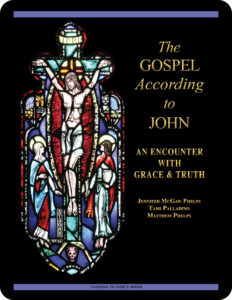 The Gospel According to John:
The Gospel According to John:
An Encounter with Grace & Truth
Lesson 23 It Is Finished
the Gospel According to John 19:17–42
Revised Standard Version Catholic Edition (RSVCE)*
New American Bible Revised Edition (NABRE)*
Catechism of the Catholic Church
ex libris (in our library)
glossary for the Gospel According to John
cross references in the Gospel According to John
next lesson: Woman, Why Are You Weeping?
This material coordinates with Lesson 23 on pages 121–125 in The Gospel According to John: An Encounter with Grace & Truth.
“Now Jesus did many other signs in the presence of the disciples, which are not written in this book; but these are written that you may believe that Jesus is the Christ, the Son of God, and that believing you may have life in his name.”—the Gospel According to John 20:30–31
welcome to our in-depth study of the Gospel According to John
We invite interested groups and individuals to check out the sample first lesson from this 25- lesson Turning to
lesson Turning to  God’s Word Catholic Bible study. These online study pages link to our free lesson videos, as well as to a glossary and cross references in the biblical text. Other study aids include maps, additional commentary, and prayers based on the primary Scripture in each lesson. The Gospel According to John: An Encounter with Grace & Truth has been granted an imprimatur and can be purchased from our website shop. If you have a Bible-related question or comment, click on one of the “ask us your question” or “what do you think” buttons on any online study page.
God’s Word Catholic Bible study. These online study pages link to our free lesson videos, as well as to a glossary and cross references in the biblical text. Other study aids include maps, additional commentary, and prayers based on the primary Scripture in each lesson. The Gospel According to John: An Encounter with Grace & Truth has been granted an imprimatur and can be purchased from our website shop. If you have a Bible-related question or comment, click on one of the “ask us your question” or “what do you think” buttons on any online study page.
open with prayer
It’s always wise to begin any Bible study with prayer, whether reading the Scriptures alone or meeting with others in a discussion study group. You can pray using your own words or use one of the opening prayers on our website. We especially like the following:
Lord Jesus, you promised to send your Holy Spirit
to teach us all things.
As we read and study your word today,
allow it to touch our hearts and change our lives. Amen.
let’s review—the Gospel According to John 18:28—19:16
In Lesson 22 My Kingship Is Not of This World, Jesus is taken to Pontius Pilate, the Roman governor of Judea. The Jews refuse to enter the praetorium to avoid being defiled before the feast of the Passover, which in the Fourth Gospel hasn’t yet occurred. The religious leaders then tell Pilate that Jesus is guilty of some still-unnamed crime because they say so. This leads to a conversation between Jesus and Pilate in which Pilate is interested in two things: whether Jesus is King of the Jews, and what is truth? Pilate decides that Jesus is innocent of any crime, but the crowd insists the robber Barabbas be released instead of Jesus. Pilate then has Jesus scourged, and the Roman soldiers mock Jesus. When Jesus is brought before the crowd again, the Jews claim that Jesus made himself the Son of God. This precipitates one more conversation between Jesus and Pilate, in which Jesus is seen to be in control. When the Jews continue to object to Jesus’ release, Pilate hands him over to be crucified.
map notes—once again, what time is it?
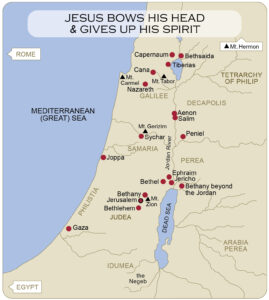 The apparent discrepancies in the accounts of Jesus’ Passion, death, and Resurrection long have mystified scholars. With Jesus’ death, the question of whether the Evangelist John was recording events according to the way the Romans marked time becomes more significant. If the Fourth Gospel is based on Roman time, the time of Jesus’ death is at serious odds with the synoptic Gospels. Two of the three synoptic writers record that Jesus was taken before Pilate early in the morning, and it seems highly unlikely that the timing suggested in the twenty-third chapter of the Gospel According to Luke allows for everything that Evangelist records happening before Jesus’ death at 3 p.m. (Also see the twenty-seventh chapter in the Gospel According to Matthew and the fifteenth chapter in the Gospel According to Mark.)
The apparent discrepancies in the accounts of Jesus’ Passion, death, and Resurrection long have mystified scholars. With Jesus’ death, the question of whether the Evangelist John was recording events according to the way the Romans marked time becomes more significant. If the Fourth Gospel is based on Roman time, the time of Jesus’ death is at serious odds with the synoptic Gospels. Two of the three synoptic writers record that Jesus was taken before Pilate early in the morning, and it seems highly unlikely that the timing suggested in the twenty-third chapter of the Gospel According to Luke allows for everything that Evangelist records happening before Jesus’ death at 3 p.m. (Also see the twenty-seventh chapter in the Gospel According to Matthew and the fifteenth chapter in the Gospel According to Mark.)
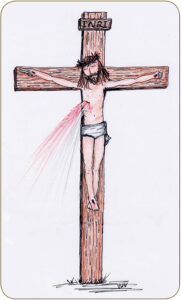 In the Gospel According to John 19:14, Jesus’ first appearance before Pilate happens about the sixth hour, or 6 a.m. if the Evangelist is following Roman time. That would mean that all four Gospels agree that Jesus appeared before Pilate early in the morning. If, however, the Fourth Gospel is following the Hebrew practice of counting the hours from sunrise, the sixth hour would have been around noon, about six hours later than what the synoptic writers suggest. The Evangelist John doesn’t give the precise time of Jesus’ death, but the three synoptic writers all agree that Jesus died at the ninth hour, which would translate from Hebrew time to about 3 p.m. our time—which we enumerate the same way the Romans did. Three p.m. is the hour that the Church traditionally has observed Jesus’ death on the cross. Click on the image (left) to enlarge the map, which appears on page 123 in The Gospel According to John: An Encounter with Grace & Truth. (Turning to God’s Word co-founder Tami Palladino’s illustration of Jesus on the cross appears on the map, “Key Events in the Gospel According to John,” on page 146, the back page of the study book.)
In the Gospel According to John 19:14, Jesus’ first appearance before Pilate happens about the sixth hour, or 6 a.m. if the Evangelist is following Roman time. That would mean that all four Gospels agree that Jesus appeared before Pilate early in the morning. If, however, the Fourth Gospel is following the Hebrew practice of counting the hours from sunrise, the sixth hour would have been around noon, about six hours later than what the synoptic writers suggest. The Evangelist John doesn’t give the precise time of Jesus’ death, but the three synoptic writers all agree that Jesus died at the ninth hour, which would translate from Hebrew time to about 3 p.m. our time—which we enumerate the same way the Romans did. Three p.m. is the hour that the Church traditionally has observed Jesus’ death on the cross. Click on the image (left) to enlarge the map, which appears on page 123 in The Gospel According to John: An Encounter with Grace & Truth. (Turning to God’s Word co-founder Tami Palladino’s illustration of Jesus on the cross appears on the map, “Key Events in the Gospel According to John,” on page 146, the back page of the study book.)
 deicide has no place in the Fourth Gospel (01:01:32)
deicide has no place in the Fourth Gospel (01:01:32)
The word “deicide,” which means “the act of killing or destroying God,” occasionally shows  up in commentaries about Jesus’ Passion. In the video for this lesson, Turning to God’s Word author Matthew Phelps discusses the emphasis that the Evangelist John places on Jesus being in control of all aspects relating to his Crucifixion. Jesus has the power to lay down his life, and he has the power to take it up again. How many examples can you see in the Gospel According to John
up in commentaries about Jesus’ Passion. In the video for this lesson, Turning to God’s Word author Matthew Phelps discusses the emphasis that the Evangelist John places on Jesus being in control of all aspects relating to his Crucifixion. Jesus has the power to lay down his life, and he has the power to take it up again. How many examples can you see in the Gospel According to John  that point to Jesus’ power over everything that’s happening? What other things has Jesus previously said or done that support the view that he has total authority over all things?
that point to Jesus’ power over everything that’s happening? What other things has Jesus previously said or done that support the view that he has total authority over all things?
The Scripture ranges for the videos that accompany this Catholic Bible study match the Scripture ranges for the sets of questions in The Gospel According to John: An Encounter with Grace & Truth. You can follow along with the video overview as Turning to God’s Word author Matthew Phelps discusses Lesson 23, “It Is Finished,” on pages 121–125 in the study book.
whatever would possess the Evangelist John to follow Roman time?
There’s a fairly reasonable explanation why the Gospel According to John uses Roman rather than Hebrew time. The Evangelist was writing the Fourth Gospel about 30 or more years after the synoptic Gospels According to Matthew, Mark, and Luke are believed to have been written, to an expanded audience living in a world dominated by Roman rule. By that point in the history of the early Church, the Roman practice for keeping time would have been normal for most of the people to whom the Evangelist was addressing his Gospel. In addition, it seems highly unlikely that the Evangelist would have chosen to take such a radical departure from the real times of day that the synoptic writers recorded for something as important as Jesus’ death.
more issues with chronology
The Evangelist John’s only mention in this section of his Gospel about the day on which Jesus was crucified occurs in the Gospel According to John 19:42, although the Gospel According to John 19:14 previously noted that it was the day of Preparation of the Passover. What makes this problematic is that the synoptic writers all refer to Jesus’ Last Supper as a Passover meal. (See the Gospel According to Matthew 26:17–29, the Gospel According to Mark 14:12–26, and the Gospel According to Luke 22:7–23.) The Fourth Gospel, on the other hand, includes an account of Jesus eating a supper with his disciples, but the Gospel According to John 13:1 specifies that it occurred before the feast of the Passover. These contradictions between what happened on which days in Holy Week aren’t easy questions to resolve. For a review of the Jewish liturgical calendar, read “The Start of Holy Week” on page 83 in The Gospel According to John: An Encounter with Grace & Truth.
ex libris—learn more about the timing of Jesus’ Passion, death & Resurrection
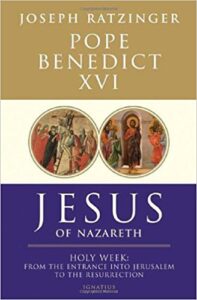 In Jesus of Nazareth: Holy Week, the second of a three-part series based on
In Jesus of Nazareth: Holy Week, the second of a three-part series based on  information about Jesus found in the Gospels, Pope Benedict XVI presents an in-depth appraisal of the pros and cons of
information about Jesus found in the Gospels, Pope Benedict XVI presents an in-depth appraisal of the pros and cons of  each Gospel position regarding the timing of events during Holy Week, and he seems to favor the view presented in the Fourth Gospel. Read excerpts and learn more about all three volumes of Jesus of Nazareth and other works related to Bible study at ex libris—main bookshelf.
each Gospel position regarding the timing of events during Holy Week, and he seems to favor the view presented in the Fourth Gospel. Read excerpts and learn more about all three volumes of Jesus of Nazareth and other works related to Bible study at ex libris—main bookshelf.
 pray with the Psalms—a connection to Jesus’ Passion
pray with the Psalms—a connection to Jesus’ Passion
Psalm 22 and Psalm 69 often are seen as a prophetic descriptions of the sort of death that Jesus will undergo in connection with his Passion and Resurrection. Prayed as Part of Friday Vigils (Week I), both Psalm 22 and Psalm 69 will be included in Lesson 11 Song of the Suffering Servant in the Turning to God’s Word Catholic Bible study  Sing a New Psalm: Communicating with God Through the Prayers of the Church—Volume II: Vigils, Day Prayer & Compline, which is scheduled for publication in 2025.
Sing a New Psalm: Communicating with God Through the Prayers of the Church—Volume II: Vigils, Day Prayer & Compline, which is scheduled for publication in 2025.
WHAT DO YOU THINK about Jesus’ death?
The account of Jesus dying on the cross can be confusing when we consider that Jesus also is God and therefore eternal.
 ? What might the Evangelist be pointing to as significant in the way that many of the details surrounding Jesus’ Crucifixion fulfill Scripture?
? What might the Evangelist be pointing to as significant in the way that many of the details surrounding Jesus’ Crucifixion fulfill Scripture?
? Read Psalm 22. How does the Gospel According to John 19:24 fulfill that Psalm?
? What other examples of prophecy being fulfilled can be seen in Psalm 22?
? Consider the significance of the Gospel According to John 19:28 as a fulfillment of Psalm 69:21 (Psalm 69:22 in the New American Bible Revised Edition [NABRE]).
? What does the Letter to the Hebrews 5:7–10 explain is accomplished by Jesus’ death?
? According to the author of the Letter to the Hebrews 5:11–14, what makes Jesus’ death  difficult to explain? You can learn more about the effect of Jesus on our present-day world in the Turning to God’s Word Catholic Bible study The Letter to the Hebrews: An Explanation of the Mechanism of Our Salvation.
difficult to explain? You can learn more about the effect of Jesus on our present-day world in the Turning to God’s Word Catholic Bible study The Letter to the Hebrews: An Explanation of the Mechanism of Our Salvation.
read the Catechism—how well do you know your faith?
In the Apostles’ and Nicene Creeds, Catholics affirm that Jesus died.
Where in the creeds can you point to evidence that Jesus’ death was temporary and didn’t “take”? If necessary, refer to the Creeds located between paragraphs 184 and 185 in the Catechism of the Catholic Church.
read the Catechism—what the blood & water mean to Christians
This section of the Gospel According to John includes the only account of blood and water flowing from Jesus’ body on the cross, a detail the Evangelist John considers so important that he breaks into his narrative to assure readers that he witnessed this himself. Paragraph 1225 in the Catechism of the Catholic Church explains that the blood and water are representations of the sacraments of new life—Eucharist and Baptism.
 1225 In his Passover Christ opened to all men the fountain of Baptism. He had already spoken of his Passion, which he was about to suffer in Jerusalem, as a “Baptism” with which he had to be baptized. The blood and water which flowed from the pierced side of the crucified Jesus are types of Baptism and the Eucharist, the sacraments of new life. From then on, it is possible “to be born of water and the Spirit” in order to enter the Kingdom of God.
1225 In his Passover Christ opened to all men the fountain of Baptism. He had already spoken of his Passion, which he was about to suffer in Jerusalem, as a “Baptism” with which he had to be baptized. The blood and water which flowed from the pierced side of the crucified Jesus are types of Baptism and the Eucharist, the sacraments of new life. From then on, it is possible “to be born of water and the Spirit” in order to enter the Kingdom of God.
See where you are baptized, see where Baptism comes from, if not from the cross of Christ, from his death. There is the whole mystery: he died for you. In him you are redeemed; in him you are saved.
 Passion—you could look it up in our archives
Passion—you could look it up in our archives
Christians often talk about Jesus’ Passion without giving it much thought. To learn about the close relationship between the words for “passion” and “suffering,” read Lost in Translation, an online column in which Turning to God’s Word author Matthew Phelps helps readers connect with ideas expressed in the original languages of the Scriptures. New Lost in Translation entries are posted on Mondays throughout the year, and past entries are archived on our website. Contact us if you’d like to receive Lost in Translation by email every week. During the Lenten season, you also can check out Jesus’ Passion: The Story of Redemptive Suffering, which isn’t available at other times of the year.
you’d like to receive Lost in Translation by email every week. During the Lenten season, you also can check out Jesus’ Passion: The Story of Redemptive Suffering, which isn’t available at other times of the year.
 the popes inspire us—grace assists us in Scripture study
the popes inspire us—grace assists us in Scripture study
Read the papal quote “Blood & Water” on page 125 in The Gospel According to John: An Encounter with Grace & Truth. In this commentary in The Gospel According to John: An Encounter with Grace & Truth, Pope St. John Paul II reflects on the biblical text in the nineteenth chapter of the Gospel According to John and cites a number of other passages from the Fourth Gospel that can be interpreted in light of the outpouring of grace flowing from Jesus’ sacrificial death.
two intriguing details
The biblical text for this lesson reveals two intriguing things. The first, found at the Gospel According to John 19:30, indicates that God always has the last word. Can you figure out the significance of the second, located at the Gospel According to John 19:41?
for additional reflection
The Church recently (in 2018) added a new memorial to honor the Blessed Virgin Mary, Mother of the Church. This optional memorial occurs on the Monday following Pentecost Sunday. The following questions are designed to help readers begin to form their own thoughts and ideas related to the Gospel According to John 19:17–42. For more reflection questions, refer to the introduction to Lesson 23 on page 121 in The Gospel According to John: An Encounter with Grace & Truth.
? What is significant about the date on the Church’s liturgical calendar that this memorial celebrated? If necessary, refer to “A New Marian Memorial” on page 123 in The Gospel According to John: An Encounter with Grace & Truth.
 ? The Gospel According to John 19:25–34 is the biblical text read at this memorial. What might the Church have had in mind when choosing this text?
? The Gospel According to John 19:25–34 is the biblical text read at this memorial. What might the Church have had in mind when choosing this text?
? One of two choices for the first reading for this Mass is the book of Genesis 3:9–15 and the book of Genesis 3:20. What makes this reading an appropriate choice?
? The second choice for the first reading is The Acts of the Apostles 1:12–14. What might make this biblical text an appropriate choice?
? How many other Marian memorials on the Church’s liturgical calendar can you name?
? Which of these are holy days of obligation?
? List as many titles for the Blessed Virgin Mary as you can.
? Which title might be easiest to explain to a non-Catholic?
? Which title might be the most difficult to explain to a non-Catholic, and why?
the best Catholic commentary about Scripture
 To find out more about how Church teaching is supported by Scripture passages in The Gospel According to John: An Encounter with Grace & Truth, check out the Index of Citations in the Catechism of the Catholic Church. Links to the primary Scripture passages in the lesson (Revised Standard Version Catholic Edition [RSVCE*]) and relevant paragraphs in the Catechism are provided here. Not every passage in the biblical text for this study is referenced in a Catechism paragraph, however.
To find out more about how Church teaching is supported by Scripture passages in The Gospel According to John: An Encounter with Grace & Truth, check out the Index of Citations in the Catechism of the Catholic Church. Links to the primary Scripture passages in the lesson (Revised Standard Version Catholic Edition [RSVCE*]) and relevant paragraphs in the Catechism are provided here. Not every passage in the biblical text for this study is referenced in a Catechism paragraph, however.
the Gospel According to John 19:19–22—paragraph 440
the Gospel According to John 19:21—paragraph 596
the Gospel According to John 19:25—paragraph 495
the Gospel According to John 19:25–27—paragraphs 726, 2618
the Gospel According to John 19:26–27—paragraphs 501, 964, 2605
the Gospel According to John 19:27—paragraphs 2677, 2679
the Gospel According to John 19:28—paragraphs 544, 607, 2561, 2605
the Gospel According to John 19:30—paragraphs 607, 624, 730, 2605
the Gospel According to John 19:31—paragraph 641
the Gospel According to John 19:34—paragraphs 478, 694, 1225
the Gospel According to John 19:36—paragraph 608
the Gospel According to John 19:37—paragraph 1432
the Gospel According to John 19:38—paragraph 575
the Gospel According to John 19:38–39—paragraph 595
the Gospel According to John 19:42—paragraphs 624, 641
ways our glossary might prove helpful
In addition to providing extra information about geographical locations, our glossary also points out  persons and places mentioned in the biblical text under multiple names or spellings. If you can remember a name but aren’t sure in which lesson it shows up, you can find it in the glossary, which lists every proper noun that appears in the primary biblical text for The Gospel According to John: An Encounter with Grace & Truth.
persons and places mentioned in the biblical text under multiple names or spellings. If you can remember a name but aren’t sure in which lesson it shows up, you can find it in the glossary, which lists every proper noun that appears in the primary biblical text for The Gospel According to John: An Encounter with Grace & Truth.
to learn more, read more Scripture
If you’re having difficulty with a passage of Scripture, it can be helpful to read the relevant  cross references—but looking these up can take time. To make that easier, we’ve compiled the cross references from the Revised Standard Version Second Catholic Edition (RSV2CE)—the translation that we reprint in our study books. That list can be found at the top of every online study page accompanying this study, and it includes links to each of the cross references in the primary biblical text for The Gospel According to John: An Encounter with Grace & Truth.
cross references—but looking these up can take time. To make that easier, we’ve compiled the cross references from the Revised Standard Version Second Catholic Edition (RSV2CE)—the translation that we reprint in our study books. That list can be found at the top of every online study page accompanying this study, and it includes links to each of the cross references in the primary biblical text for The Gospel According to John: An Encounter with Grace & Truth.
don’t forget about our indexes & extra online material

 If you’re trying to locate information about a specific Scripture passage, you can look it up in the index at the back of the study book or sample lesson. If you want to find a particular commentary, you can look up its title in the topics index. To learn more about another book of the Bible for which there’s a Turning to God’s Word study, visit the online study directories to read the commentaries and watch any accompanying videos. Finally, if you have a question or would like to make a comment about any of our studies, you can use one of the “ask us your question” or “what do you think” buttons to email our authors.
If you’re trying to locate information about a specific Scripture passage, you can look it up in the index at the back of the study book or sample lesson. If you want to find a particular commentary, you can look up its title in the topics index. To learn more about another book of the Bible for which there’s a Turning to God’s Word study, visit the online study directories to read the commentaries and watch any accompanying videos. Finally, if you have a question or would like to make a comment about any of our studies, you can use one of the “ask us your question” or “what do you think” buttons to email our authors.
ex libris—Church documents & books about religious topics
You can find links to magisterial documents referred to in Turning to God’s Word Catholic Bible studies  at ex libris—magisterial documents. This page includes a listing of significant recent encyclicals as well as a number of historical Church documents. Recommended books related to Scripture study can be found at ex libris—main bookshelf.
at ex libris—magisterial documents. This page includes a listing of significant recent encyclicals as well as a number of historical Church documents. Recommended books related to Scripture study can be found at ex libris—main bookshelf.
wondering how to pronounce some of these words?
The following link is to a reading from the New International Version (NIV) Bible. To listen, click on the audio icon above the printed text. Although not taken from the translations used in our study materials, the NIV reading provides an audio guide to pronunciation of words in this lesson’s primary biblical text. A close online version of the translation of the Bible used in Catholic liturgy in the United States as well as an audio guide for daily Mass readings for the current month can be found on the website of the United States Conference of Catholic Bishops (USCCB).
the Gospel According to John 19:17–42 (NIV)
 close with Bible-based prayer related to this lesson
close with Bible-based prayer related to this lesson
Many of our Catholic study groups like to conclude their discussions with a prayer based on the scriptural focus of their lesson, and some participants include Scripture-specific prayer in their individual study. If you’re uncomfortable composing your own Bible-based prayers, you can follow our four easy steps, or you can use the following prayer based on this lesson’s text from the Gospel According to John.
God our Father, you sent your Son to die
in order that we might attain eternal salvation.
Help us to keep his sacrifice ever in mind
and to live courageous lives in accord
with the love he demonstrated.
We ask this through Jesus Christ, our Lord. Amen.
Lesson 24 Woman, Why Are You Weeping?—the Gospel According to John 20:1–18
Lesson 22 My Kingship Is Not of This World—the Gospel According to John 18:28—19:16
you also may like our free Lenten study of Jesus’ Passion (digital only)
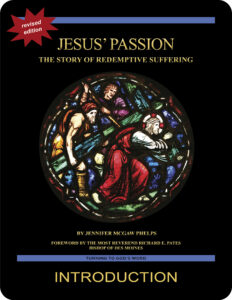 Jesus’ Passion: The Story of Redemptive Suffering is a five-lesson Catholic Bible study offering an in-depth look at the biblical foundations of the movie The Passion of the Christ. This revised study, which has been granted an imprimatur, contains all of the original material of the 2004 edition as well as many new features in an improved, reader-friendly format. Click on the book’s cover to view the introduction. Free digital lessons of Jesus’ Passion: The Story of Redemptive Suffering are available on the website during Lent.
Jesus’ Passion: The Story of Redemptive Suffering is a five-lesson Catholic Bible study offering an in-depth look at the biblical foundations of the movie The Passion of the Christ. This revised study, which has been granted an imprimatur, contains all of the original material of the 2004 edition as well as many new features in an improved, reader-friendly format. Click on the book’s cover to view the introduction. Free digital lessons of Jesus’ Passion: The Story of Redemptive Suffering are available on the website during Lent.
start a Turning to God’s Word Bible study
 Thank you for your interest in The Gospel According to John: An Encounter with Grace & Truth.
Thank you for your interest in The Gospel According to John: An Encounter with Grace & Truth.  Information about beginning a Turning to God’s Word Bible study can be found at start a Bible study. Tami, Matthew, and I are available to answer questions and offer support. Contact us if you’d like to start one of our studies or have your schedule listed with other TtGW study groups on our website. —Jennifer
Information about beginning a Turning to God’s Word Bible study can be found at start a Bible study. Tami, Matthew, and I are available to answer questions and offer support. Contact us if you’d like to start one of our studies or have your schedule listed with other TtGW study groups on our website. —Jennifer
*There are seven deuterocanonical books in the Old Testament—the Books of Tobit, Judith, Wisdom, Sirach, Baruch, and First and Second Maccabees, as well as some passages in the Books of Esther and Daniel. Protestants usually refer to these works as “apocryphal,” a word that means “outside the (Protestant) canon” because they’re excluded from most Protestant Bibles. The word “deuterocanonical” means “second canon”; Catholics use that word to refer to any section of the Catholic Old Testament for which there are no extant, or existing, Hebrew manuscripts. All of the deuterocanonical books appear in the Septuagint, the earliest remaining versions of which date to the 1st century B.C. This Greek translation of the Old Testament was in common use by Jews at the time of Jesus. Learn more by reading How Do Catholic & Protestant Bibles Differ?
Turning to God’s Word printed Bible studies use the 2006 Revised Standard Version Second Catholic Edition (RSV2CE) translation for all Scripture references except those to the Psalms, which are taken from The Abbey Psalms and Canticles, prepared by the Benedictine monks of Conception Abbey and published in 2020 by the United States Conference of Catholic Bishops (USCCB). All Scripture links for the online study pages for The Gospel According to John: An Encounter with Grace & Truth are to the 1966 Revised Standard Version Catholic Edition (RSVCE) translation. The New International Version (NIV) audio recordings follow the same chapter and verse numbering as the RSV Catholic translations, but the NIV translation doesn’t include the deuterocanonical books and passages.
The 1966 RSVCE uses archaic pronouns and verb forms such as “thee,” “thou,” “didst” in the Psalms and in direct quotations attributed to God. The 2006 RSV2CE replaces these with more accessible English. The few significant translation changes in the RSV2CE include rendering almah as “virgin” in the Book of Isaiah 7:14 and restoring the term “begotten” in the Gospel According to John 3:16.
Numbering varies for some passages in this Bible study. Turning to God’s Word studies (print and digital) follow the numbering in the Revised Standard Version Catholic translations (RSV2CE and RSVCE). Discrepancies in the New American Bible Revised Edition (NABRE) are noted in the Index of Scripture Citations in the study book and the online sample.
 You can learn more about the Psalms by viewing a sample lesson from the Turning to God’s Word Catholic Bible study Sing a New Psalm: Communicating with God Through the Prayers of the Church—Volume I: Lauds & Vespers. The second part of that study, Sing a New Psalm: Communicating with God Through the Prayers of the Church—Volume II: Vigils, Day Prayer & Compline, is scheduled for publication in 2025. Some verse numbers may vary in different translations of the Psalms.
You can learn more about the Psalms by viewing a sample lesson from the Turning to God’s Word Catholic Bible study Sing a New Psalm: Communicating with God Through the Prayers of the Church—Volume I: Lauds & Vespers. The second part of that study, Sing a New Psalm: Communicating with God Through the Prayers of the Church—Volume II: Vigils, Day Prayer & Compline, is scheduled for publication in 2025. Some verse numbers may vary in different translations of the Psalms.
